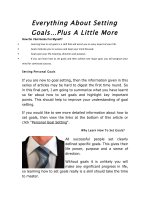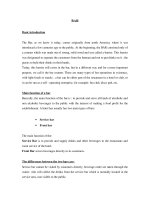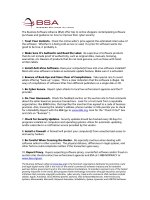Tài liệu Simplified pdf
Bạn đang xem bản rút gọn của tài liệu. Xem và tải ngay bản đầy đủ của tài liệu tại đây (73.56 KB, 4 trang )
A Simplified
OD MODEL
Organizational Development (OD) is one of two major models that managers must
understand to perform total quality management. HRD + OD = TQM
Organizational Development Model
•
The nine elements of this OD MODEL are organized into three sets of
relationships.
•
Each set defines relationships that must be understood, developed and
maintained to maximize profitability.
•
Each OD element asks a basic question about an organization. Leaders
determine the organizational design by the answers they choose for
each of the nine questions.
OD MODEL Elements and Sets
ORGANIZATION (Relationships: Workforce, Leadership, Ownership)
•
PURPOSE: Why are we here?
•
PATTERNS: How are we put together?
•
PLANS: How do we document and display?
•
PEOPLE: How do our people fit?
•
PROFIT$: How do we meet cash and capital needs?
•
PLACE: Do we have adequate physical resources?
WORK FLOW (Relationships: Supplier, Interpersonal, Customer)
•
PRODUCTS: What value do we create?
•
PROCESS: How do we make next steps happen?
MARKETS (Relationships: Government, Markets, Community)
•
POSITIONING: Are we where our product or service sells?
High Quality Organizational Performance is the result of Profitability and
Productivity through People
HRD
Human Resources Development
Just how important is HRD?
•
It is easier to say "People are are greatest asset!" than it is to put that
belief into "measurable action!"
•
There is no doubt that in many industries the next major competitive
edge will be in maximizing people resources.
•
Companies that learn to continuously "develop human resources" not
only stand a greater chance to survive in the next century, but will also
be more profitable.
•
This page is dedicated to helping leaders put their beliefs about the
importance of developing their human resources into action (better
decisions, people friendly organizational designs, adequate resources,
etc.).
Professional human resources management (HRD) must blend with organizational
management (OD) and quality management (TQM) to produce world class
qualityproducts and services.
Three Simplified, Integratable
MODELS for TQM Managers
ORGANIZATIONAL DEVELOPMENT MODEL
•
This OD model maximizes elements key to profitability:
Organization, Work Flow and Markets.
HUMAN RESOURCES DEVELOPMENT MODEL
•
This HRD model maximizes elements key to performance:
Leadership, Workforce, Company
TOTAL QUALITY MANAGEMENT MODEL
•
This TQM model blends organizational and individual models
together for world class quality.
Related HRD Topics and Resources:
•
Integrating training, development and education.
•
Linking TQM with HRD Models
•
Corporate HRD Planning
Linking HRD to TQM
•
The models for HRD and TQM are closely linked.
•
One cannot be developed, changed or operated without affecting the
other.
•
Both have the same essential model elements of ORGANIZATION,
INDIVIDUALS and QUALITY MANAGEMENT.
HRD
CORPORATE TRAINING & DEVELOPMENT
•
• PREREQUISITES OVERVIEW: Corporate training and
development does not happen by itself, nor does it happen in a
vacuum. Although these prerequisites do not have to be complete to
have the vital T&D function operational, the more established they are,
the more effective T&D can be in reaching corporate goals of
readiness, quality and resilience in the marketplace.
•
Established (Published) Vision and Goals
•
Written Training and Development Philosophy
o
T&D Staff Involvement: Short Term vs. Long Term
Strategies
o
Employment Attitude: Contracts and Commitments
o
Integration of Systems: Recruitment, Appraisal, T&D,
Promotion, Bonus, Succession, Etc.
o
Resource Utilization: Internal, External
•
Long-Term Budget Support
HRD
Training and Development Issues
Being cautious of your T&D assumptions:
•
Learning does not assure the skill to perform.
•
Skills can be performed with out understanding.
•
Understanding does not guarantee the ability train others.
•
Consulting requires more than understanding, skills, and teaching
ability.
Definitions.
Training, Development and Education are often used interchangably,
but they are different and meet different needs. Because they are
often linked, overlapping, nested, and conducted simultaneously,
agreement on their basic differences is important to training and
development professionals. These basic definitions can help clarify
human resource development tactical and strategic functions. They can
be refined or deepened, but they need to be identified as different
processes in the continuous maximization of human potential.
TRAINING: Attainment of skills necessary to perform tasks.
•
Focus: SKILL
•
Benchmarks: BEHAVIORAL
•
Horizons: SHORT TO MEDIUM TERM
•
Duration: CONTINUOUS
•
Measures: BOTTOM-LINE
DEVELOPMENT: Reaching the maxium personal competency
performing assignments.
•
Focus: PROCESS
•
Benchmarks: READINESS
•
Horizons: MEDIUM TO LONG TERM
•
Duration: MILESTONES
•
Measures: COMPETENCY
EDUCATION: Completing curriculum-based achievements.
•
Focus: CONCEPTUAL
•
Benchmarks: CAPACITY, ACHIEVEMENT
•
Horizons: CAREER
•
Duration: DEGREE, DIPLOMA, CERTIFICATE
•
Measures: PROFESSIONALISM
Performance:
There are three basic elements to evaluation of performance that are
helpful in attaining and evaluationg human resources development.
CAPACITY
•
Personal abilities necessary to perform tasks and assignments.
•
(Mental, Physical, Social, Spiritual)
SKILLS
•
Behavioral competencies necessary to perform tasks and assignments.
•
(Comprehension, Tactical, Verbal, Interpersonal)
MOTIVATION
•
Willingness to perform tasks and assignments.
•
(Intrinsic, Extrinsic, Life)









